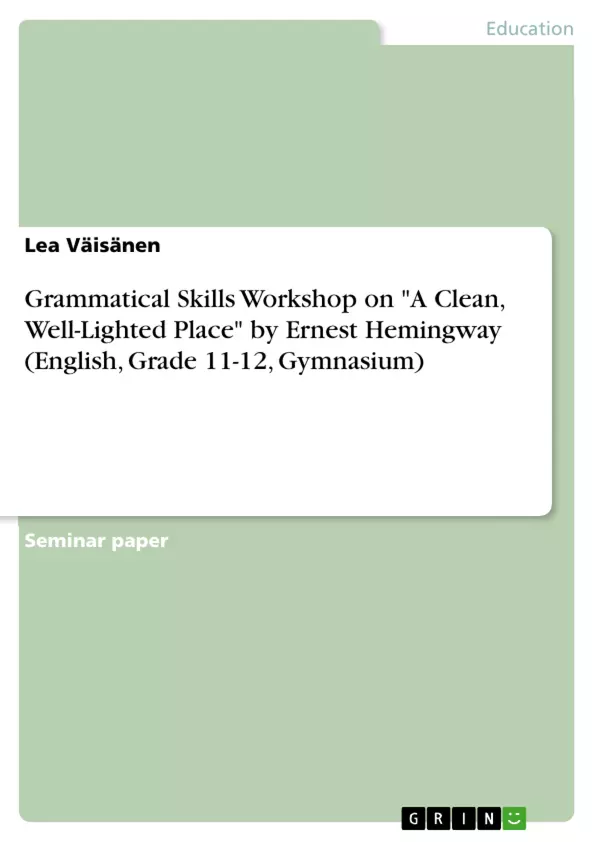This workshop aims to clarify and to deepen the use of adjectives versus adverbs as well as the differences between the simple present and the present progressive in the German Oberstufe, i.e. grade 11-12 (Gymnasium), 12-13 (Stadtteilschule). In this context it introduces the students to modernist English literature by dealing with Ernest Hemingway’s 1933 short story A Clean, Well-Lighted Place.
The Hamburger Bildungsplan explains how project work combines the three didactic principles, student-, activity- as well as process-orientation. It fosters the students’ proficiencies in all competence areas (see Bildungsplan Gymnasium 16) (communication competence, intercultural competence and method competence (see 13)). In this context The Hamburger Bildungsplan demands the fostering of a text and media competence (see Bildungsplan Oberstufe 1). Further, it states the importance of a solidified repertoire of extended grammatical structures, as well as a structural awareness for the English language (see Bildungsplan Gymnasium 25). It further accentuates the development of an awareness of analogies and differences between languages (see ibid.).
First I will introduce the short story A Clean, Well-Lighted Place by Ernest Hemingway and briefly analyse the theme and plot. In the next two chapters I will outline the adjectives and adverbs that are being used and refer to phrases in simple present and in present progressive. In the following chapters I will outline the approach and structure of the workshop and then detail the lessons. The material for the workshop is listed in the appendix.
Inhaltsverzeichnis (Table of Contents)
- Introduction
- A Clean, Well-Lighted Place
- Adjectives and Adverbs
- Simple Present and Present Progressive
- Approach and Structure
- Lesson 1
- Lesson 2
- Appendix: Material
Zielsetzung und Themenschwerpunkte (Objectives and Key Themes)
This workshop focuses on clarifying and deepening the use of adjectives versus adverbs, as well as the differences between the simple present and the present progressive in the German Oberstufe. It achieves this by introducing students to modernist English literature through Ernest Hemingway's 1933 short story "A Clean, Well-Lighted Place."
- Understanding the grammatical concepts of adjectives, adverbs, simple present and present progressive.
- Exploring the use of these grammatical structures in literary context.
- Analyzing the themes of loneliness, sorrow, and gratitude in Hemingway's short story.
- Examining the significance of social differences and marginalization in the story.
- Developing text-exploitation techniques to analyze complex narrative and thematic structures.
Zusammenfassung der Kapitel (Chapter Summaries)
The introduction provides an overview of the workshop's objectives and its connection to the German Bildungsplan. Chapter 2 focuses on Hemingway's "A Clean, Well-Lighted Place," exploring its narrative structure, theme, and use of various rhetorical devices.
Chapter 3 delves into the use of adjectives and adverbs in the short story, highlighting Hemingway's unique style and providing examples of relevant vocabulary.
Schlüsselwörter (Keywords)
The workshop focuses on grammatical structures such as adjectives, adverbs, simple present, and present progressive, utilizing Ernest Hemingway's "A Clean, Well-Lighted Place" as a literary example. Key themes explored include loneliness, sorrow, gratitude, social differences, marginalization, and text-exploitation techniques.
- Quote paper
- Lea Väisänen (Author), 2021, Grammatical Skills Workshop on "A Clean, Well-Lighted Place" by Ernest Hemingway (English, Grade 11-12, Gymnasium), Munich, GRIN Verlag, https://www.grin.com/document/1154137



